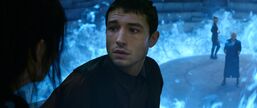Several magical animals may have been born in China.
On the street, Newt met Zou Wu for the first time .
The first second was fierce, but when Newt took out the cat stick, his pupils dilated, his mouth opened slightly, and he was very well-behaved.
In Fantastic Beasts: The Crimes of Grindelwald , this behemoth from the circus looks like a big cat.
I have to say that although Sniff is cute, Zou Wu is more in my heart.
Not only because of its exaggerated contrast, but also because it comes from China.
To be precise, it comes from the first mythological novel in my country, The Classic of Mountains and Seas.
Volume 12 "Hainei Bei Jing" has a statement -
"Lin's state has a rare beast, as big as a tiger, full of five colors, with a tail longer than the body.
As a creature in ancient Chinese legends, it is said that it inhabits a place called "Lin's Country". It is about the size of a tiger, its tail is colorful, and it is longer than its body. It can travel thousands of miles a day.
However, The Classic of Mountains and Seas focuses on geographical description. It only briefly introduces the habits and characteristics of Zou Wu, and it is not exhaustive.
But it is not the only one. It has also appeared in many documents of later generations, and these have shaped a three-dimensional Zouwu.
In the "Historical Records: Zhou Benji" compiled by Sima Qian, there is the first story of Zuwu.
At the end of the Shang Dynasty, the ignorant King Zhou listened to the slanderous words of the ministers and decided that Ji Chang, the Marquis of Xibo, threatened the court and imprisoned him in the yǒu.
Ji Chang's retainer San Yisheng was the savior, and he deliberately brought three treasures and presented them to King Zhou, in order to make a difference.
They are the stunning beauty of the state of Xin, the god horse Jiliang who claims to give a rider a thousand-year lifespan, and the especially rare beast Zouwu.
King Zhou's treasure queen, Longyan Dayue, pardoned Ji Chang on the same day, and gave him the right to conquer and do whatever he wanted to other vassal states that threatened the emperor's rule.
Later, Ji Chang used this privilege to incorporate the surrounding princes and expand his power. Later, it was the story of King Wu's attack on Zhou, which is a later story.
However, Zuwu is also one-third of Ji Chang's life-saving benefactor. Ji Chang is especially grateful for this. When his grandson, King Jichan of Zhou Cheng, was in power, he recited the music of the former king and specially composed the music of the same name for Zuwu.
The melody of the tune has long been lost, but the lyrics are included in the "Book of Songs", called "Guofeng·Zhaonan·Zuyu" (in ancient times, "Wu" and "Yu" were homophonic, and Zouyu was also Zouwu).
It was also from the Zhou Dynasty that Zuwu jumped from a beast to a benevolent beast certified by the emperor.
Since then, the records about Zouwu have become more and more mysterious. In the description of "Mao Shi Gu Xun Biography" in the early Western Han Dynasty, it has become a benevolent beast by nature, who can't bear to trample even grass and trees, and does not eat living things.
What is even more exaggerated is that whenever the emperor is benevolent, virtuous, and wise, it will be inspired to appear.
Due to the powerful deification, during the two Jin Dynasties, there were also Wuyu banners .
A flag embroidered with the pattern of Zuwu is used to convey the decree to relieve the troops. According to legend, regardless of the disparity in military strength and the geometry of the battle, seeing this flag will unconditionally retreat, which is comparable to the sword of Shangfang.
There is such a story in the Book of Jin.
During the Rebellion of the Eight Kings, Emperor Hui of Jin was one of the eight kings to pacify Sima Wei , and he especially used the Zouyu banner as his flag. Seeing this, his soldiers put down their weapons and dispersed, and Sima Wei was captured alive.
During the two Jin Dynasties, there were many examples of relying on the Zouyu banner to decide the victory or defeat, and it was only at that time that the flag had such an amazing effect. After the Jin Dynasty fell, the Zouyu banner was also lost.
However, the story of Zou Wu is not over. It is mentioned in the Record of Emperor Taizong of the Ming Dynasty that it appeared twice during the Yongle period of the Ming Dynasty alone.
Once in the second year of Yongle, Zhou Wang Zhu Chi (sù) came to the court and specially presented his brother Zhu Di as a gift for his enthronement. Nine years later, the magistrate of Cao County learned and behaved well.
Not necessarily how benevolent, virtuous, and wise Zhu Di was, but it was enough to show his enthusiasm for Zuwu.
The reason for this was probably because the throne was not right in the first place. Zhu Di just wanted to take advantage of Zuwu's benevolent beast to tell the people that he was still a wise king.
After that, the relevant records of Zuwu became more and more scarce, and when the Manchus were in power in the Qing Dynasty, they did not believe this.
Without the legend, Zuwu has become a real mystery.
So what kind of species is this Zuwu, which only survives in various ancient documents?
Nowadays, as human beings have a wider understanding of the world, many rare birds have been proved to be the imagination of the ancients, but many exotic beasts have also been inferred to exist.
Just like Phoenix lives in mythology, Momonga lives in reality.
The magical animal Zuwu is likely to belong to the latter, and contemporary scholars generally have three speculations about its prototype.
The first is the white tiger.
Aside from the evidence of the "big as a tiger" in "Shan Hai Jing", Lu Ji, a scholar of the Three Kingdoms, wrote in "Mao Poems, Plants, Trees, Birds, Animals, Insects and Fishes":
"Zuyu is a white tiger. Heiwen has a tail longer than his body. He doesn't eat living things, and he doesn't walk on grass. If a king is virtuous, he will see it, and he will arrive in response to his virtue."
Lu Ji directly pointed out that the white tiger is Zouwu, and the white tiger in the "Shan Hai Jing" is also one of the four great beasts, which can be said to be conclusive.
Even in the Xuande period of the Ming Dynasty, someone painted the appearance of Zouwu, which is exactly the same as the white tiger in reality.
The second is the snow leopard.
In the description of Zuwu in later generations, the original "five-colored complete set" in "The Classic of Mountains and Seas" has been changed to "white tiger and black pattern", while the white long hair of the snow leopard is covered with black irregular rings, which are very consistent.
Although white tigers also have black and white stripes, "the tail is longer than the body " is really far-fetched, but for snow leopards, it is completely out of the question.
In addition, as a rock-dwelling animal, snow leopards mostly inhabit rock cliffs in the mountains, and naturally seldom step on grass and trees, which coincides with the description of the ancients.
In addition, snow leopards are rare, and invisibly fit the theory of rare animals. Therefore, snow leopards are the most mainstream speculation today.
The third is panda.
This is also the most nonsense. The reason for this statement is that its coat color conforms to the black and white chapters, and the main food is bamboo and fresh living things.
Of course, apart from these two points, there is no consensus.
The Zouwu in the movie took the most mysterious part of the legend, and the appearance directly copied the " tiger body and head" described in the Ming Dynasty "Yang Wenmin Collection ".
Therefore, the audience saw a monster that looks like a tiger but not a tiger, a lion but not a lion, and it is closer to the magical animal in the sense of this film.
Be it a white tiger, a snow leopard or a lion, they all belong to the cat family, and it's easy to tease the cat.
While the jury is still out, Aunt Rowling has clearly captured the essence.
Zuwu has a long heritage, cute and fierce, but it is not the most outstanding beast in "Shan Hai Jing".
As a strange book that laid the foundation for our mythological system, the monsters in the "Book of Mountains and Seas" are as numerous as stars, and can be called an encyclopedia of magical animals.
For example, the well-known gluttonous food is far more famous than Zuwu. It is described in the "Northern Second Classics" as "shaped like a sheep's body with a human face, eyes under the armpit, tiger teeth and human hands".
What really penetrates the hearts of the people is the bottomless appetite , which was perfectly restored in Zhang Yimou's "Great Wall" in 2016 .
There is also a monster with a human head and a bird body called Chi Corpse . The "Western Classic of the Great Wilderness" says: "Red Corpse, Yu Ye, there is a woman bathing in the moon, a bird with five plucks, and a human face with hair."
In 2001, in Tsui Hark's "Shushan Biography" , red corpses appeared. They appeared harmless to humans and animals, but in fact they could invade the primordial spirit and control people's thoughts.
In addition, Henggongyu is also a star monster in "The Classic of Mountains and Seas".
It is described in the book that the Henggong fish grows in the stone lake that is frozen all the year round, about seven or eight feet long. It is in the water during the day and turns into an adult at night. .
In Stephen Chow's [Journey to the West: Conquering the Demons] in 2013 , it became the incarnation of the sand monk.
And from "North by overseas" in phase Liu , minister of water is God's co-workers, then Dayu rival, according to legend its "snake nine, countless cannibalism, wherever he went, to make into a flood plain."
In the end, he was killed by Da Yu, but his blood was more powerful than the flood. Wherever it flows, nothing is born.
In 2014's [Wonderful Night at the Museum 3] , the Chinese Pavilion BOSS is a mini Xiangliu, with special effects, cool and eye-catching.
From this point of view, not only Zou Wu, but all the rare and exotic animals in "The Classic of Mountains and Seas" are the treasure house of film creation.
However, the people of the country are always late.
Today's public marvels at the grandeur of the Middle-earth of "Lord of the Rings" and the splendor of the wizarding world of "Harry Potter".
The 40 countries, 550 mountains, 300 rivers, and more than 400 kinds of gods and monsters in "The Classic of Mountains and Seas" have long buried a local magical dimension for us.
Imagination never fades due to cultural differences. In [Fantastic Beasts: The Crimes of Grindelwald], Zou Wu is an oriental fantasy, still galloping on the streets of the West.
Newt gets along very well with it, when will we be able to mingle with the animals and birds of The Classic of Mountains and Seas?
And all the answers were written at the beginning of the story. Several magical animals may have been born in China.
-
Author / Yaoyao Wine
The article was first published on the WeChat public account "Bao Ci Er"
View more about Fantastic Beasts: The Crimes of Grindelwald reviews











